热门标签
热门文章
- 1pg mysql 联表查询_postgresql多表查询语句优化
- 210年经验的嵌入式工程师,会选择了什么职位?
- 3Unity3D 项目专属文件夹须知_unity工程目录那些文件不能删
- 4【初学者指南】OpenAI-Sora:最新文生成视频教程 - 如何入门_sora教程
- 5毕业设计之 --- 基于图像识别的跌倒检测算法_物体检测,物体分割毕业设计
- 6为什么很多人都在吹ChatGPT改变世界?一文全面了解
- 7【线性代数】齐次与非齐次线性方程组有解的条件_齐次方程有非零解m=n
- 8MongoDB批量写入操作_mongo批量写入
- 9嵌入式开发的发展方向和前景_嵌入式操作系统的方向 和市场
- 10mybatis-generator构建表问题_ignorequalifiersatruntime
当前位置: article > 正文
SpringAMQP消息队列(SpringBoot集成RabbitMQ)_spring-boot-starter-amqp
作者:小丑西瓜9 | 2024-02-25 06:20:27
赞
踩
spring-boot-starter-amqp
一、初始配置
1、导入maven坐标
- <!--rabbitmq-->
- <dependency>
- <groupId>org.springframework.boot</groupId>
- <artifactId>spring-boot-starter-amqp</artifactId>
- </dependency>
2、yml配置
- spring:
- rabbitmq:
- host: 你的rabbitmq的ip
- port: 5672
- username: guest
- password: guest
二、基本消息队列

1、创建队列
访问接口:http://localhost:15672,账号密码都为guest
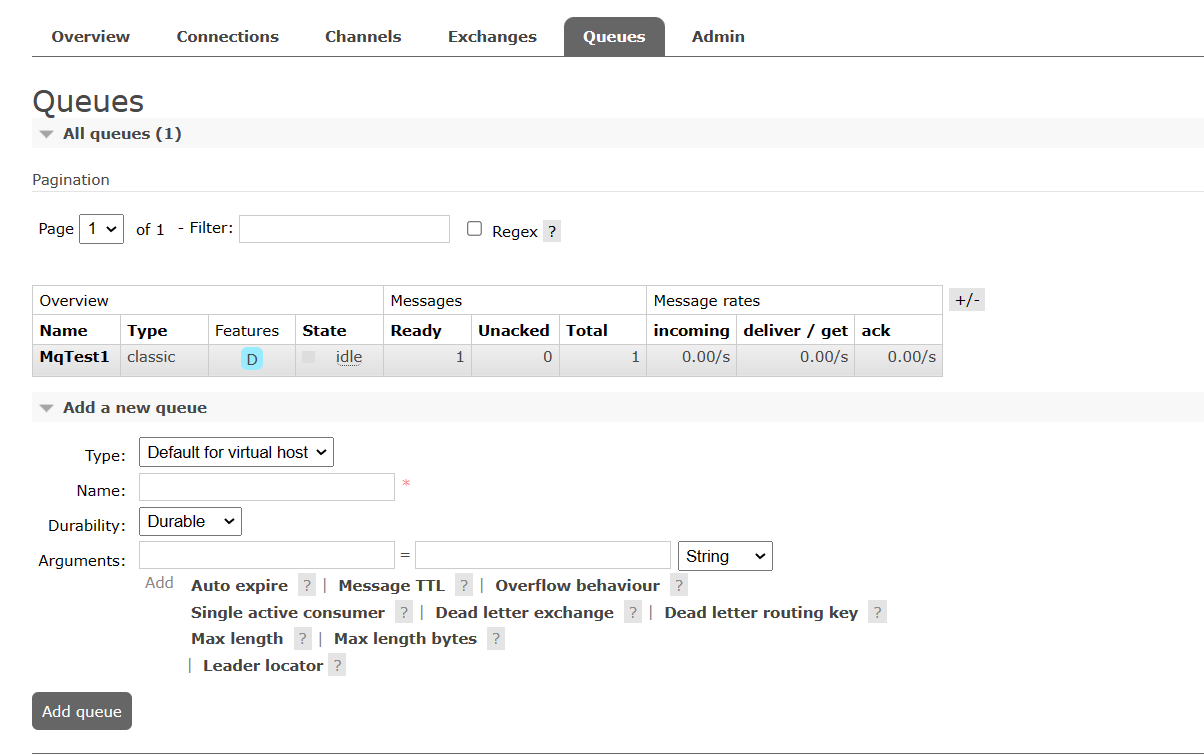
进入后左下角有Add queue添加队列,我已添加队列为MqTest1
2、发布消息
- @SpringBootTest
- class RabbitMQDemoPublishApplicationTests {
- @Autowired
- private RabbitTemplate rabbitTemplate;
-
- @Test
- void contextLoads() {
- String queue="MqTest1";
- String message="message1";
- rabbitTemplate.convertAndSend(queue,message);
- }
-
- }
此时可以看到队列有一个消息
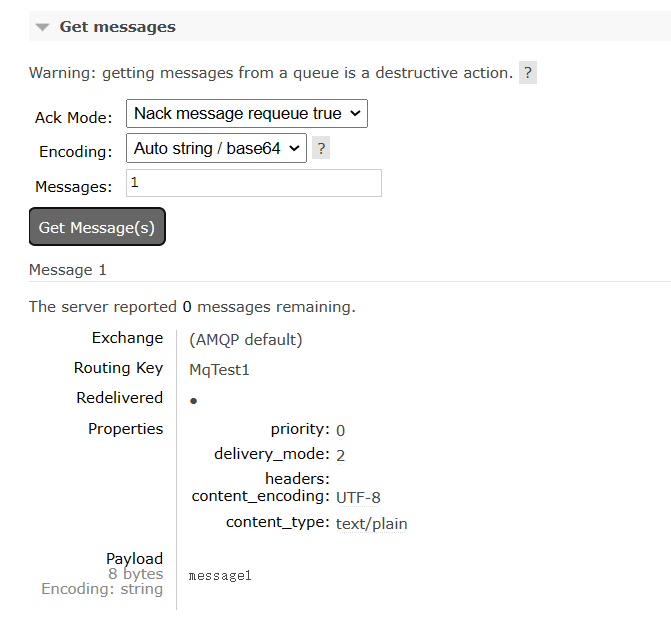
3、接受消息
- package com.rabbitmqdemoconsumer.rabbitmq;
-
- import org.springframework.amqp.rabbit.annotation.RabbitListener;
- import org.springframework.stereotype.Component;
-
- @Component
- public class SpringRabbitLeistener {
-
- @RabbitListener(queues = "MqTest1")
- public void listenSimpleQueueMessage(String msg){
- System.out.println("接收到的消息:"+msg);
- }
- }
此时控制台输出接收到的消息

三、工作消息队列(Work Queue)

可以提高消息处理速度,避免队列消息堆积
1、发布消息
- @SpringBootTest
- class RabbitMQDemoPublishApplicationTests {
- @Autowired
- private RabbitTemplate rabbitTemplate;
-
- @Test
- void contextLoads() {
- String queue="MqTest1";
- String message="message1";
- for (int i=0;i<10;i++){
- rabbitTemplate.convertAndSend(queue,message);
- }
- }
-
- }
此时队列有10条消息
2、接受消息
- package com.rabbitmqdemoconsumer.rabbitmq;
-
- import org.springframework.amqp.rabbit.annotation.RabbitListener;
- import org.springframework.stereotype.Component;
-
- @Component
- public class SpringRabbitLeistener {
-
- @RabbitListener(queues = "MqTest1")
- public void listenSimpleQueueMessage1(String msg){
- System.out.println("consume1接收到的消息:"+msg);
- }
- @RabbitListener(queues = "MqTest1")
- public void listenSimpleQueueMessage2(String msg){
- System.out.println("consume2接收到的消息:"+msg);
- }
- }

3、控制台输出结果
- consume1接收到的消息:message1
- consume2接收到的消息:message1
- consume1接收到的消息:message1
- consume2接收到的消息:message1
- consume1接收到的消息:message1
- consume2接收到的消息:message1
- consume1接收到的消息:message1
- consume2接收到的消息:message1
- consume1接收到的消息:message1
- consume2接收到的消息:message1
4、消息预取问题
但是此时有一个问题就是消息预取,比如队列有10条消息,两个消费者各自直接先预取5个消息,如果一个消费者接受消息的速度慢,一个快,就会导致一个消费者已经完成工作,另一个还在慢慢处理,会造成消息堆积消费者身上,要解决这个问题需要在yml文件配置相关配置
- rabbitmq:
- host: 43.140.244.236
- port: 5672
- username: guest
- password: guest
- virtual-host: /
- listener:
- simple:
- prefetch: 1 #每次只能取一个,处理完才能取下一个消息
这样可以避免消息预取导致堆积
四、发布订阅模式
exchange是交换机,负责消息路由,但不存储消息,路由失败则消息丢失
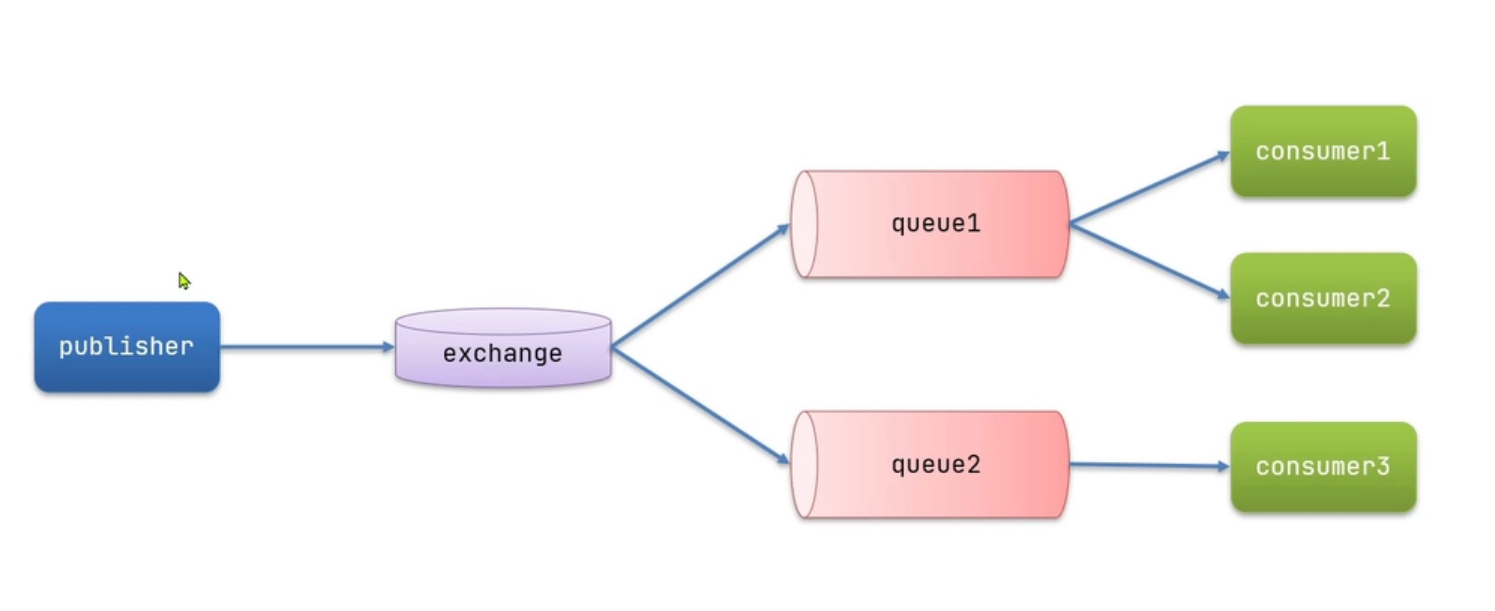
五、发布订阅模式之广播模式(Fanout)

1、Fanout配置类(@Bean声明)
- package com.rabbitmqdemoconsumer.config;
-
- import org.springframework.amqp.core.Binding;
- import org.springframework.amqp.core.BindingBuilder;
- import org.springframework.amqp.core.FanoutExchange;
- import org.springframework.amqp.core.Queue;
- import org.springframework.context.annotation.Bean;
- import org.springframework.context.annotation.Configuration;
-
- @Configuration
- public class FanountConfig {
- //交换机声明
- @Bean
- public FanoutExchange fanoutExchange(){
- return new FanoutExchange("FanountExchange");
- }
- //声明队列1
- @Bean
- public Queue Fanount_Qeueue1(){
- return new Queue("Fanount_Qeueue1");
- }
- //声明队列2
- @Bean
- public Queue Fanount_Qeueue2(){
- return new Queue("Fanount_Qeueue2");
- }
- //绑定交换机和队列
- @Bean
- public Binding bindingFanount_Qeueue1(Queue Fanount_Qeueue1,FanoutExchange fanoutExchange){
- return BindingBuilder.bind(Fanount_Qeueue1).to(fanoutExchange);
- }
- @Bean
- public Binding bindingFanount_Qeueue2(Queue Fanount_Qeueue2,FanoutExchange fanoutExchange){
- return BindingBuilder.bind(Fanount_Qeueue2).to(fanoutExchange);
- }
- }

可以看到声明的队列

已经声明的交换机(第一个)
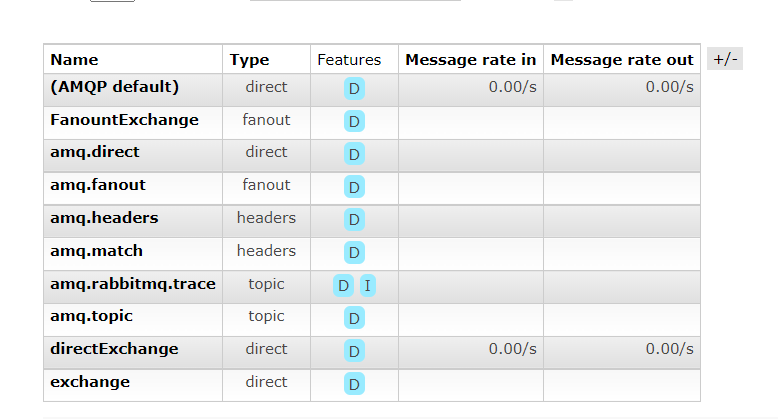
绑定关系
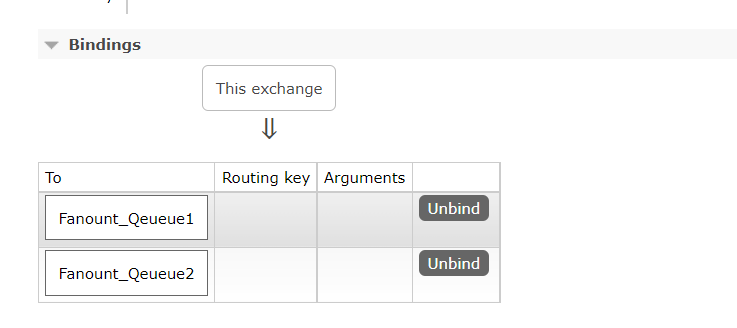
2、发送消息
首先发送10条消息,经过交换机转发到队列
- @SpringBootTest
- class RabbitMQDemoPublishApplicationTests {
- @Autowired
- private RabbitTemplate rabbitTemplate;
-
- @Test
- void contextLoads2() {
- String exchange="FanountExchange";
- String message="message";
- for (int i=0;i<10;i++){
- rabbitTemplate.convertAndSend(exchange,"",message);
- }
- }
-
- }
此时可以看到两个队列各自有十条消息

3、接受消息
- //监听交换机Fanount_Qeueue1
- @RabbitListener(queues = "Fanount_Qeueue1")
- public void listenFanountQeueue1(String msg){
- System.out.println("Fanount_Qeueue1接收到的消息:"+msg);
- }
- //监听交换机Fanount_Qeueue2
- @RabbitListener(queues = "Fanount_Qeueue2")
- public void listenFanountQeueue2(String msg){
- System.out.println("Fanount_Qeueue2接收到的消息:"+msg);
- }
控制台结果如下(共发送20条,每个队列10条)
六、发布订阅模式之路由模式(Direct)
会将消息根据规则路由到指定的队列
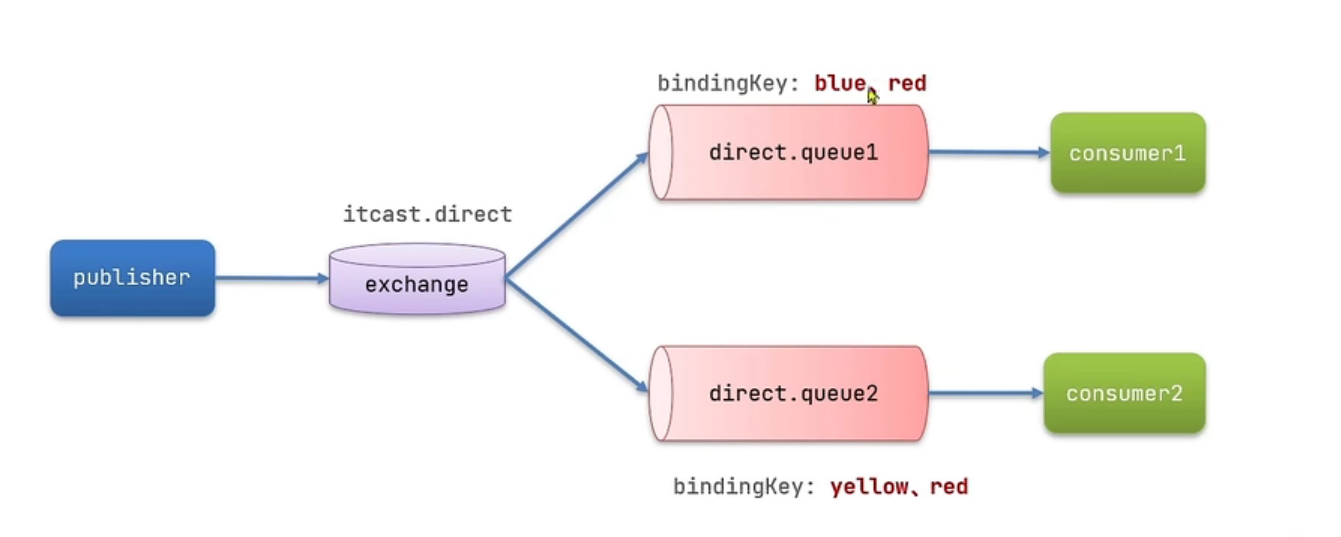
1、声明(基于@RabbitListener声明)
- package com.rabbitmqdemoconsumer.rabbitmq;
-
- import org.springframework.amqp.core.ExchangeTypes;
- import org.springframework.amqp.rabbit.annotation.Exchange;
- import org.springframework.amqp.rabbit.annotation.Queue;
- import org.springframework.amqp.rabbit.annotation.QueueBinding;
- import org.springframework.amqp.rabbit.annotation.RabbitListener;
- import org.springframework.stereotype.Component;
-
- @Component
- public class SpringRabbitLeistener {
-
- /**
- * 绑定交换机和队列,并为key赋值
- * @param msg
- */
- @RabbitListener(bindings = @QueueBinding(
- value = @Queue(name = "DirectQueue1"),
- exchange = @Exchange(name = "DirectExchange",type = ExchangeTypes.DIRECT),
- key = {"red","blue"}
- ))
- public void listenDirectQueue1(String msg){
- System.out.println("listenDirectQueue1接收到的消息:"+msg);
- }
-
-
- @RabbitListener(bindings = @QueueBinding(
- value = @Queue(name = "DirectQueue2"),
- exchange = @Exchange(name = "DirectExchange",type = ExchangeTypes.DIRECT),
- key = {"red","yellow"}
- ))
- public void listenDirectQueue2(String msg){
- System.out.println("listenDirectQueue2接收到的消息:"+msg);
- }
- }

此时可以看到声明的队列
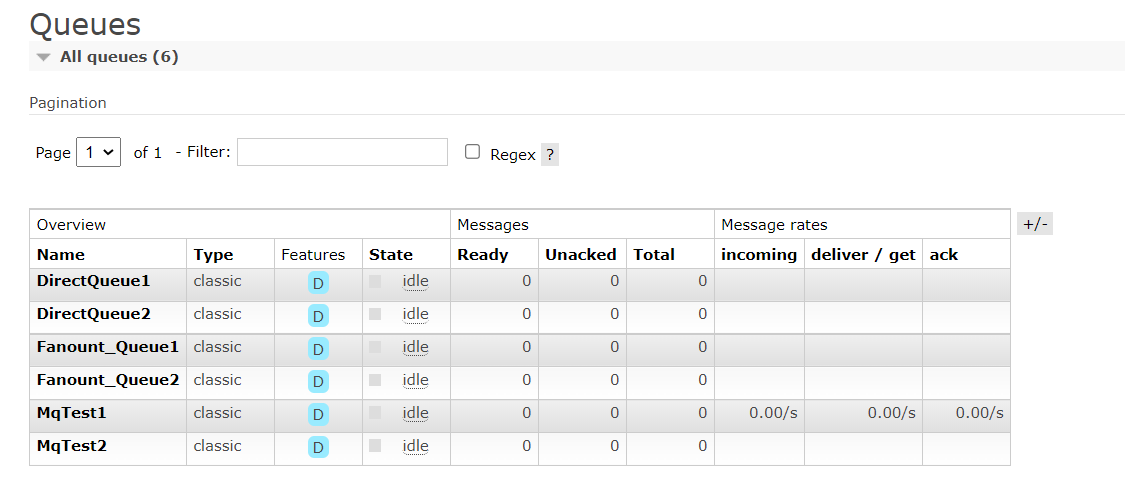
声明的交换机(第一个)
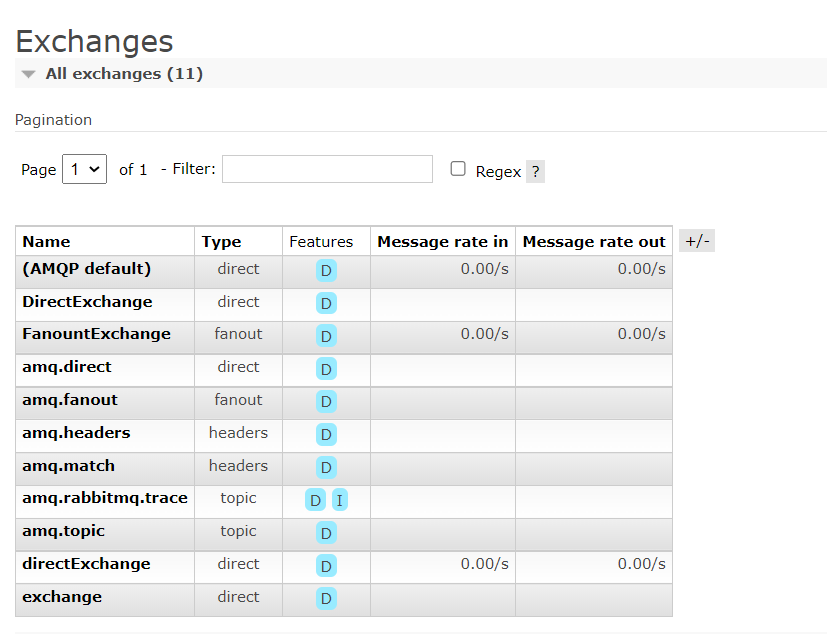
绑定关系
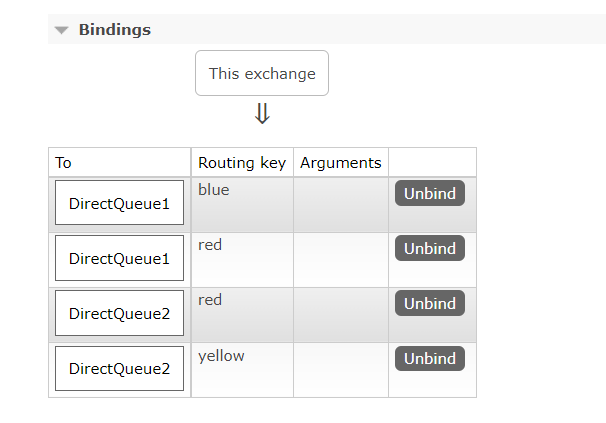
2、发送给blue
发送消息
-
- @SpringBootTest
- class RabbitMQDemoPublishApplicationTests {
- @Autowired
- private RabbitTemplate rabbitTemplate;
-
- @Test
- void contextLoads2() {
- String exchange="DirectExchange";
- String message="HelloWorld";
- for (int i=0;i<10;i++){
- rabbitTemplate.convertAndSend(exchange,"blue",message);
- }
- }
-
- }

接收消息
- listenDirectQueue1(red,blue)接收到的消息:HelloWorld
- listenDirectQueue1(red,blue)接收到的消息:HelloWorld
- listenDirectQueue1(red,blue)接收到的消息:HelloWorld
- listenDirectQueue1(red,blue)接收到的消息:HelloWorld
- listenDirectQueue1(red,blue)接收到的消息:HelloWorld
- listenDirectQueue1(red,blue)接收到的消息:HelloWorld
- listenDirectQueue1(red,blue)接收到的消息:HelloWorld
- listenDirectQueue1(red,blue)接收到的消息:HelloWorld
- listenDirectQueue1(red,blue)接收到的消息:HelloWorld
- listenDirectQueue1(red,blue)接收到的消息:HelloWorld
3、发送给red
发送消息
- @SpringBootTest
- class RabbitMQDemoPublishApplicationTests {
- @Autowired
- private RabbitTemplate rabbitTemplate;
-
- @Test
- void contextLoads2() {
- String exchange="DirectExchange";
- String message="HelloWorld";
- for (int i=0;i<10;i++){
- rabbitTemplate.convertAndSend(exchange,"blue",message);
- }
- }
-
- }
接收消息
- listenDirectQueue1(red,blue)接收到的消息:HelloWorld
- listenDirectQueue2(red,yellow)接收到的消息:HelloWorld
- listenDirectQueue2(red,yellow)接收到的消息:HelloWorld
- listenDirectQueue1(red,blue)接收到的消息:HelloWorld
- listenDirectQueue1(red,blue)接收到的消息:HelloWorld
- listenDirectQueue2(red,yellow)接收到的消息:HelloWorld
- listenDirectQueue1(red,blue)接收到的消息:HelloWorld
- listenDirectQueue2(red,yellow)接收到的消息:HelloWorld
- listenDirectQueue2(red,yellow)接收到的消息:HelloWorld
- listenDirectQueue1(red,blue)接收到的消息:HelloWorld
- listenDirectQueue2(red,yellow)接收到的消息:HelloWorld
- listenDirectQueue1(red,blue)接收到的消息:HelloWorld
- listenDirectQueue2(red,yellow)接收到的消息:HelloWorld
- listenDirectQueue1(red,blue)接收到的消息:HelloWorld
- listenDirectQueue1(red,blue)接收到的消息:HelloWorld
- listenDirectQueue2(red,yellow)接收到的消息:HelloWorld
- listenDirectQueue2(red,yellow)接收到的消息:HelloWorld
- listenDirectQueue1(red,blue)接收到的消息:HelloWorld
- listenDirectQueue2(red,yellow)接收到的消息:HelloWorld
- listenDirectQueue1(red,blue)接收到的消息:HelloWorld

七、发布订阅模式之广播模式(Topic)
Queue与Exchange指定BindingKey可以使用通配符:
#:代指0个或多个单词
*:代指一个单词
比如:
bindingkey: china.# ->中国的所有消息
bindingkey: #.weather ->所以国家的天气
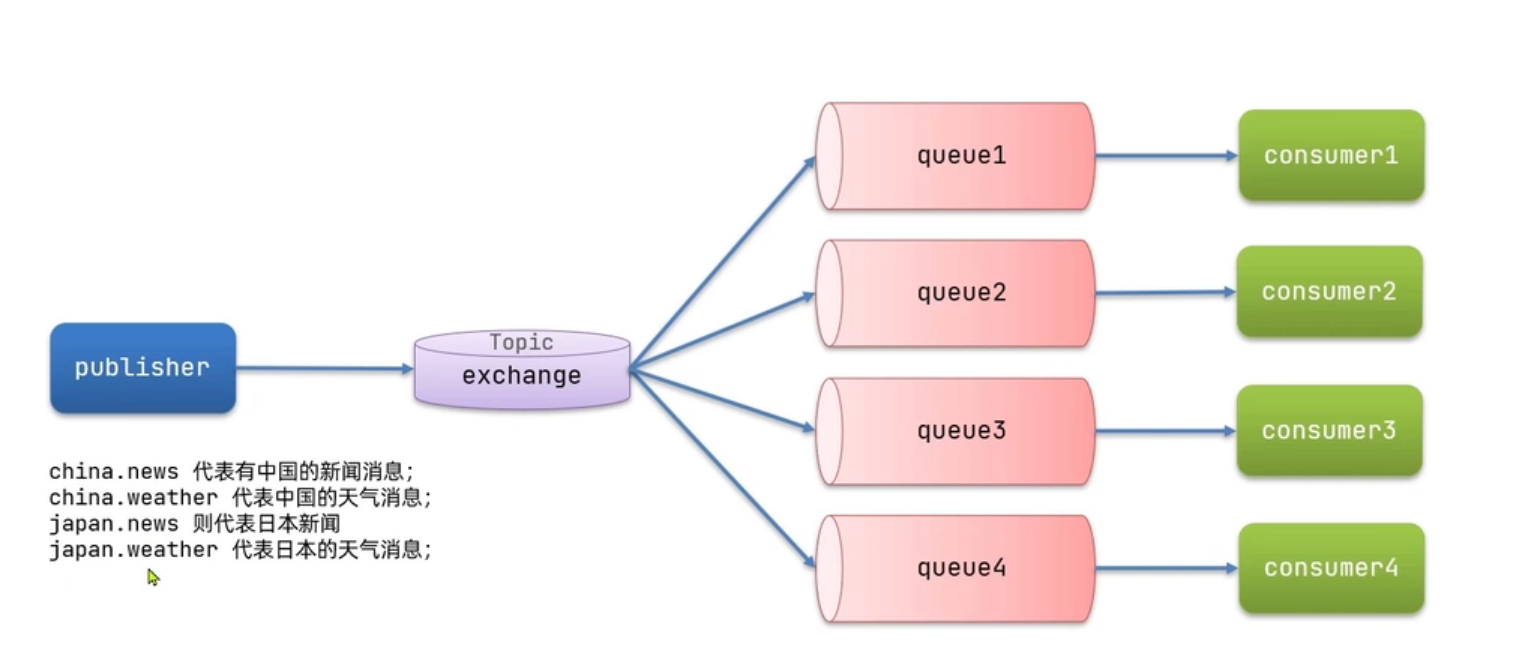
1、声明
- @RabbitListener(bindings = @QueueBinding(
- value = @Queue(name = "TopicQueue1"),
- exchange = @Exchange(name = "TopicExchange",type = ExchangeTypes.TOPIC),
- key = {"china.#"}
- ))
- public void listenTopicQueue1(String msg){
- System.out.println("listenTopicQueue1接收到的消息:"+msg);
- }
-
- @RabbitListener(bindings = @QueueBinding(
- value = @Queue(name = "TopicQueue2"),
- exchange = @Exchange(name = "TopicExchange",type = ExchangeTypes.TOPIC),
- key = {"#.news"}
- ))
- public void listenTopicQueue2(String msg){
- System.out.println("listenTopicQueue2接收到的消息:"+msg);
- }

队列
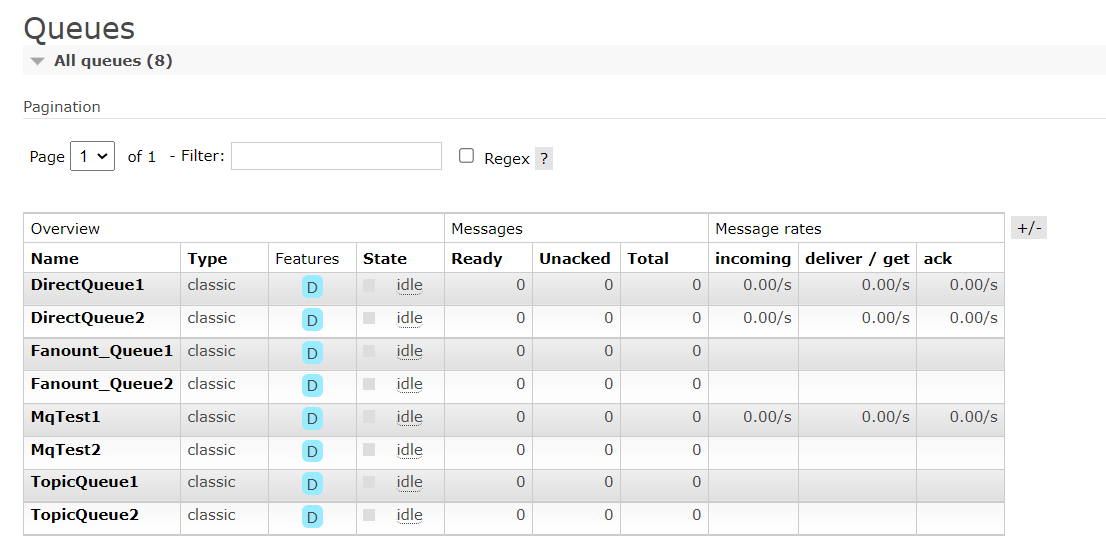
交换机(第四个)
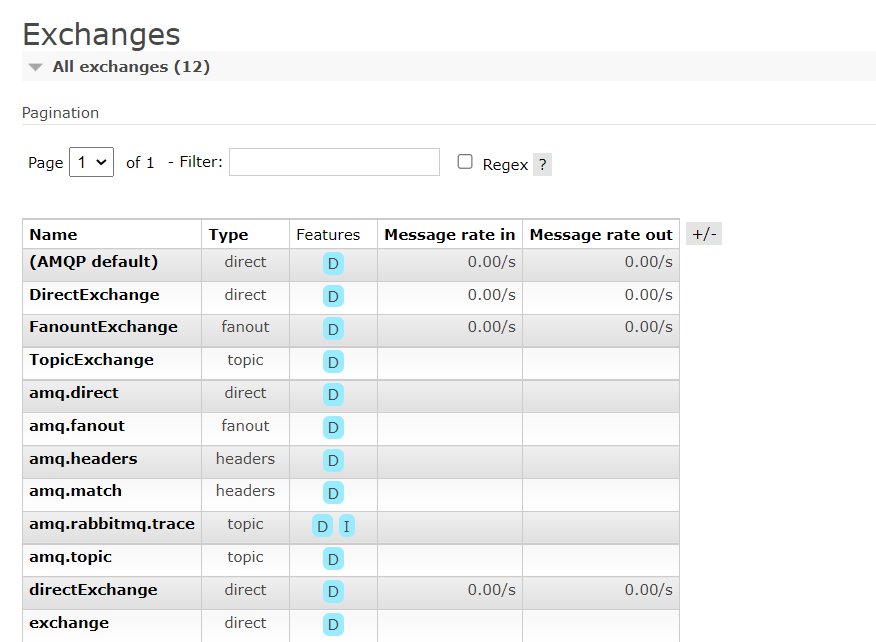
绑定关系
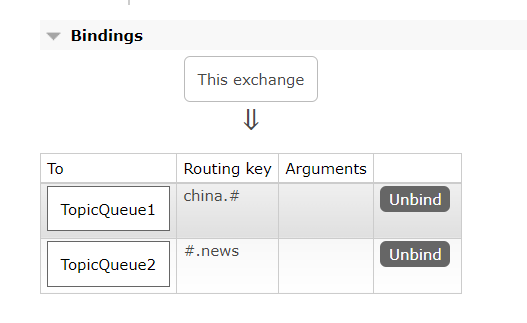
2、发送消息(测试1)
- package com.rabbitmqdemo;
-
- import org.junit.jupiter.api.Test;
- import org.springframework.amqp.rabbit.core.RabbitTemplate;
- import org.springframework.beans.factory.annotation.Autowired;
- import org.springframework.boot.test.context.SpringBootTest;
-
- @SpringBootTest
- class RabbitMQDemoPublishApplicationTests {
- @Autowired
- private RabbitTemplate rabbitTemplate;
-
- @Test
- void contextLoads2() {
- String exchange="TopicExchange";
- String message="HelloWorld";
- for (int i=0;i<10;i++){
- rabbitTemplate.convertAndSend(exchange,"china.news",message);
- }
- }
-
- }

接收消息
3、发送消息(测试2)
发送消息
- package com.rabbitmqdemo;
-
- import org.junit.jupiter.api.Test;
- import org.springframework.amqp.rabbit.core.RabbitTemplate;
- import org.springframework.beans.factory.annotation.Autowired;
- import org.springframework.boot.test.context.SpringBootTest;
-
- @SpringBootTest
- class RabbitMQDemoPublishApplicationTests {
- @Autowired
- private RabbitTemplate rabbitTemplate;
-
- @Test
- void contextLoads2() {
- String exchange="TopicExchange";
- String message="HelloWorld";
- for (int i=0;i<10;i++){
- rabbitTemplate.convertAndSend(exchange,"china.weather",message);
- }
- }
-
- }

接收消息
- TopicQueue1接收到的消息:HelloWorld
- TopicQueue1接收到的消息:HelloWorld
- TopicQueue1接收到的消息:HelloWorld
- TopicQueue1接收到的消息:HelloWorld
- TopicQueue1接收到的消息:HelloWorld
- TopicQueue1接收到的消息:HelloWorld
- TopicQueue1接收到的消息:HelloWorld
- TopicQueue1接收到的消息:HelloWorld
- TopicQueue1接收到的消息:HelloWorld
- TopicQueue1接收到的消息:HelloWorld
声明:本文内容由网友自发贡献,不代表【wpsshop博客】立场,版权归原作者所有,本站不承担相应法律责任。如您发现有侵权的内容,请联系我们。转载请注明出处:https://www.wpsshop.cn/w/小丑西瓜9/article/detail/139294
推荐阅读
相关标签


